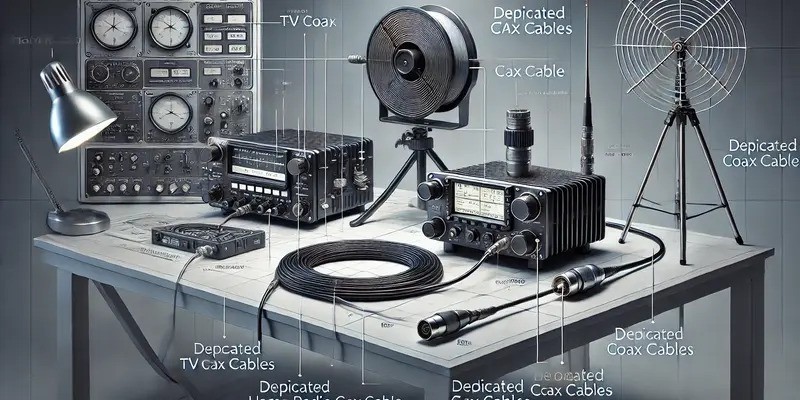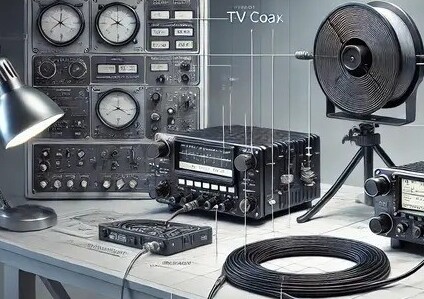Ham radio enthusiasts often seek ways to maximize their setup and utilise existing equipment. One common question is whether it’s possible to run ham radio signals through TV coax cables. In this article, we’ll explore the pros and cons of this idea, discuss its feasibility, and provide alternatives for more efficient and safer ham radio operation.
Introduction to Running Ham Radio Through TV Coax
When you’re setting up a ham radio station, you might be looking at ways to optimise costs and reduce the number of cables you need. TV coax cables, which are commonly used for cable TV or satellite connections, are readily available and inexpensive. Given this, it’s understandable why someone might wonder, “Can you run ham radio through TV coax?”
While it is technically possible to use TV coax for ham radio transmission, several important factors must be considered. These include signal integrity, safety concerns, and the suitability of TV coax for the high frequencies typically used in ham radio operations.
Understanding Ham Radio and TV Coax Cable
To answer this question thoroughly, it’s essential to understand both ham radio and TV coax cables.
Ham Radio is a form of two-way communication using radio frequencies. Operators use ham radios to communicate over long distances for personal, educational, and emergency purposes. Ham radios typically use a wide range of frequencies, often in the HF (High Frequency) or VHF (Very High Frequency) bands.
TV Coax Cable is a type of electrical cable used to carry radio frequency signals, primarily for transmitting television signals from an antenna or cable source to a TV. These cables are designed to minimise interference and maintain signal quality over longer distances. However, they are optimised for the relatively low-frequency signals used for television broadcasting, which are different from the higher-frequency signals used by ham radios.
Is It Safe to Run Ham Radio Through TV Coax?
Safety is a significant concern when operating any radio equipment, especially when considering using cables for unintended purposes. TV coax cables are not specifically designed for the high power and frequency ranges used by ham radio operators, and this can create several issues.
- Signal Interference: The quality of the signal may degrade when using TV coax for ham radio. Coaxial cables are built to support the signal strength and frequency requirements of TV systems, which are different from ham radio’s needs. This mismatch could lead to signal distortion or poor transmission quality.
- Overloading the Cable: TV coax cables are not built to handle the power levels that a ham radio might generate. Using TV coax can result in overheating or damage to the cable, potentially causing fire hazards or equipment failure.
- Equipment Damage: Running high-power signals through TV coax cables could also damage other devices connected to the cable, such as your TV or modem, which could void warranties or cause costly repairs.
For these reasons, it’s important to exercise caution when running ham radio through TV coax cables.
How to Run Ham Radio Through TV Coax
If you are determined to try running a ham radio through TV coax, there are a few steps to follow to minimise risk and improve performance:
- Use a Proper Antenna: Ensure that the antenna connected to the coax is compatible with the frequencies used by ham radio. Antennas designed for TV signals will not perform well with ham radio frequencies, so investing in the right antenna is crucial.
- Limit Power Output: To avoid overloading the coax cable, limit the power output of your ham radio. High-power transmissions could cause the cable to overheat or degrade. It’s advisable to use lower-power settings during experimentation.
- Ensure Grounding and Shielding: Coaxial cables are designed to provide shielding, but it’s still vital to ensure your setup is grounded properly. This will reduce the chances of electrical surges or interference, providing a safer experience.
- Use a Suitable Connector: Make sure to use the correct connectors when attaching your ham radio equipment to the TV coax. A mismatch in connectors could result in signal loss or improper transmission.
Alternatives to Using TV Coax for Ham Radio
While TV coax cables can technically be used for ham radio, there are better alternatives that are specifically designed for this purpose. Using coax cables made for ham radio offers superior performance and safety. Here are some common options:
- RG-8X or RG-58 Coax: These cables are widely used in ham radio setups and offer better shielding, durability, and higher power handling capabilities than TV coax cables. They are specifically built to transmit higher frequencies and signals with minimal loss.
- LMR-400 Coax: For serious ham radio operators, LMR-400 coax is an excellent option. It provides superior signal quality, can handle higher power levels, and is designed for low loss over long distances.
- Twisted-Pair Cables: Another option is to use twisted-pair cables with appropriate adapters. These cables can handle high frequencies and are relatively easy to set up.
Proper ham radio coax cables can ensure better performance, fewer safety risks, and improved signal quality.

Conclusion: Can You Run Ham Radio Through TV Coax?
In conclusion, while it is technically possible to run ham radio through TV coax, it’s not recommended for optimal performance or safety. TV coax cables are not designed to handle the higher power and frequency requirements of ham radios, and this could lead to interference, damage to equipment, or safety hazards.
If you’re serious about ham radio operations, it’s best to invest in proper coax cables designed for the task. For more information about choosing the right cables and accessories for your ham radio setup, visit Byte Varsity, where you can explore a variety of radio-related products to enhance your setup.
By using the appropriate equipment and taking the necessary precautions, you’ll ensure that your ham radio experience is both safe and enjoyable.
